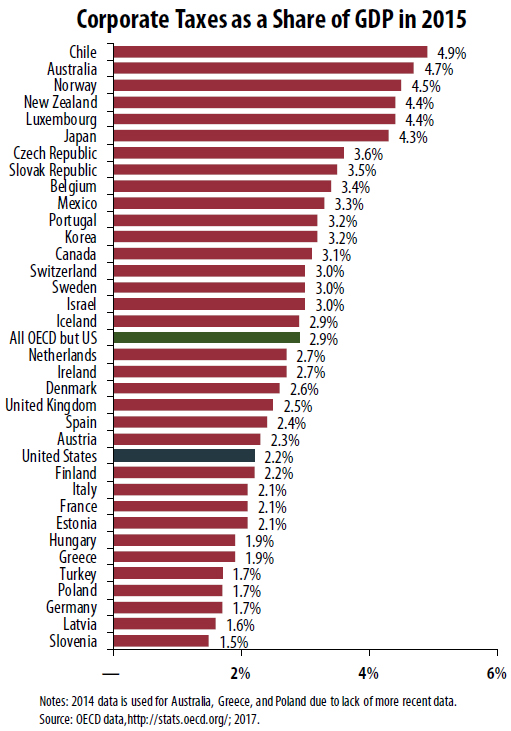Corporate income taxes in the United States as a share of the economy are well below the average among developed nations, according to an analysis of the most recent data from the Organization for Economic Cooperation and Development (OECD). Data from the OECD show that U.S. corporate taxes as a percentage of GDP are 2.2 percent, which is 24 percent less than the 2.9 percent weighted average among the 34 other OECD countries for which data were available.
U.S. corporate income taxes have declined sharply as a percentage of GDP since 1945. [i] This long-term decline is due, in part, to a relentless campaign by corporate interests to cut the statutory tax rate and add a myriad of tax breaks to the code. Yet there is a growing and vocal movement among well-financed lobbying groups to push federal lawmakers to lower the statutory corporate tax rate even further. These business-backed groups claim that the U.S. corporate tax rate is too high, citing the 35 percent federal statutory tax rate. But that narrow argument ignores the breadth of loopholes and tax breaks now embedded in the tax code. A 2017 study by the Institute on Taxation and Economic Policy (ITEP) examined eight years of data and found that Fortune 500 companies paid an average federal effective corporate income tax rate of only 21.2 percent, which is just over half of the nominal U.S. statutory rate of 35 percent.[ii] That same study found that many profitable, large U.S. corporations such as General Electric, International Paper and PG&E paid no federal corporate income taxes over eight years.
Rather than cutting the rate as many lawmakers are proposing, a better approach to corporate tax reform would be to eliminate the tax breaks and loopholes that allow many companies to get away with not paying their fair share. This approach would not only make the tax system more fair, but it would also help ensure that we have enough resources for critical investments in infrastructure, transportation, education, health, public and food safety, all of which benefit the public and corporations alike.

[i] Office of Management and Budget, “The Budget for Fiscal Year 2017, Historical Tables,” Table 2.3,
https://www.whitehouse.gov/omb/budget/Historicals
[ii] Institute on Taxation and Economic Policy, “The 35 Percent Corporate Tax Myth.” March 2017. https://itep.org/corporatestudy/




